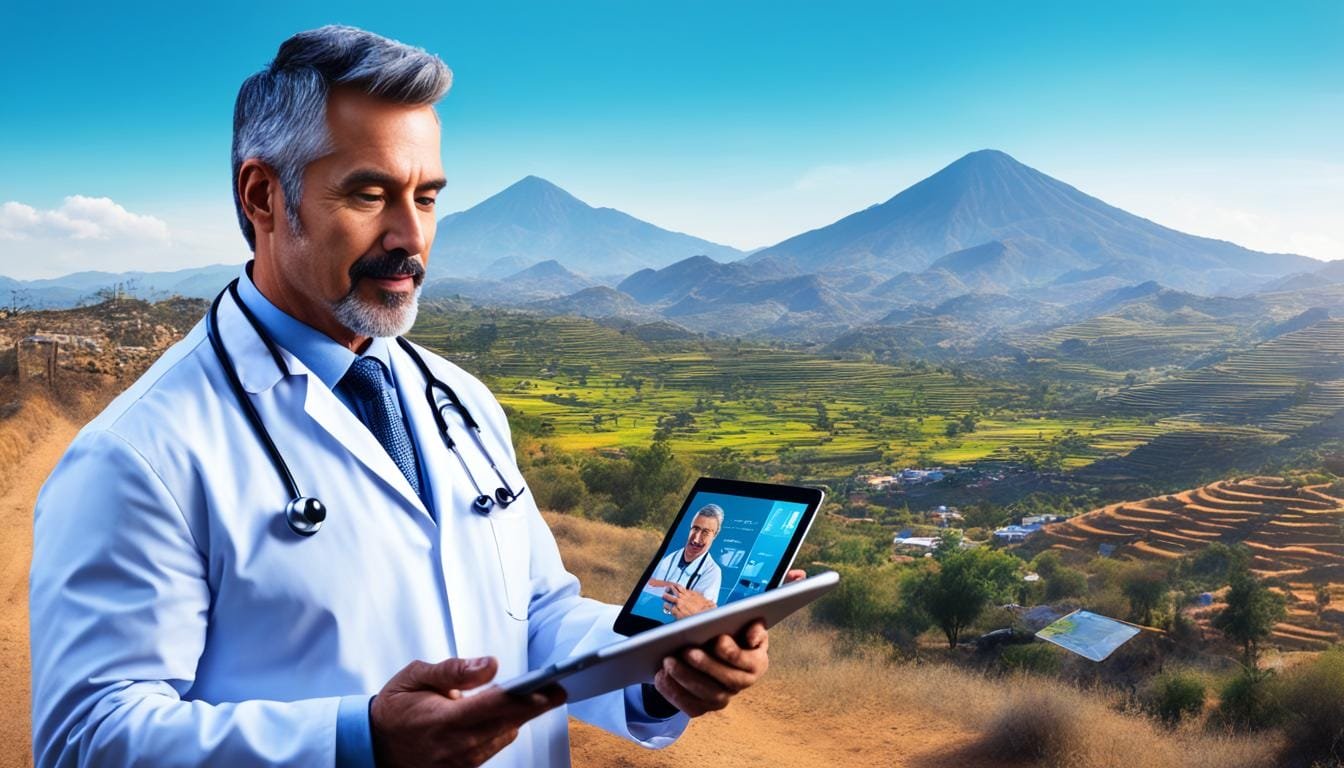In Mexico, accessing healthcare is becoming more convenient and efficient, thanks to the advent of telemedicine. This innovative approach leverages digital platforms to connect patients with doctors and specialists, overcoming geographical barriers and offering online medical consultations. With virtual healthcare services on the rise, Mexico is embracing technological advancements to deliver quality healthcare to its population.
Key Takeaways:
- Telemedicine is revolutionizing healthcare in Mexico, providing convenient access to medical consultations through digital platforms.
- Virtual healthcare services are breaking down geographical barriers, enabling patients in remote areas to consult with doctors and specialists.
- Technology empowers patients in Mexico to actively participate in their healthcare through health applications, which track physical activity, diet, and sleep.
- Advanced medical imaging and artificial intelligence enhance the accuracy of diagnosis and treatment in Mexico.
- Technology plays a crucial role in promoting preventive healthcare practices and educating individuals on disease prevention in Mexico.
Overcoming Geographic Barriers with Telemedicine
Telemedicine has emerged as a crucial solution in Mexico for overcoming geographic barriers that limit access to healthcare. In rural and remote areas, where medical facilities are scarce, telemedicine allows patients to consult with doctors and specialists through digital platforms. This eliminates the need for travel and reduces costs, while also facilitating timely consultations and early diagnosis of diseases.
With remote medical services in Mexico, individuals residing in remote or underserved areas can easily access telehealthcare solutions. Telemedicine providers in Mexico offer a range of digital platforms and tools that enable patients to connect with healthcare professionals from the comfort of their homes. Through telemedicine, individuals can receive medical advice, consultations, and even prescriptions, without the need for physical visits.
One of the key advantages of telemedicine is that it provides access to healthcare resources to those who may otherwise face challenges in seeking medical care. Geographical distance and lack of transportation can often be significant barriers, particularly in countries with expansive rural areas like Mexico. By leveraging telehealthcare solutions, individuals in remote locations can receive the medical attention they need, regardless of their physical location.
Telemedicine not only overcomes geographical barriers but also promotes preventive care and timely interventions. Through remote medical services in Mexico, patients can schedule virtual doctor appointments and receive early diagnosis and treatment recommendations, leading to better health outcomes. This is especially valuable for individuals with chronic conditions or those who require specialized care but live too far from medical facilities.
Telemedicine allows patients to consult with doctors and specialists through digital platforms, breaking down geographical barriers and providing convenient access to medical consultations.
Additionally, telemedicine offers a cost-effective solution for both patients and healthcare systems. By reducing the need for travel and eliminating geographic constraints, telemedicine significantly lowers healthcare expenses. Patients no longer have to incur transportation costs, accommodation fees, or time off work to seek medical care.
The convenience and accessibility of telemedicine have become even more evident during the recent COVID-19 pandemic. With the implementation of social distancing measures and lockdowns, traditional healthcare services faced challenges in providing in-person consultations. Telemedicine quickly became a viable alternative, ensuring that individuals could still access healthcare services while minimizing their exposure to potential health risks.
Overall, telemedicine has proven to be a transformative approach to healthcare delivery in Mexico. By leveraging telehealthcare solutions, individuals in remote areas can overcome geographic barriers and access the medical care they need. Additionally, telemedicine providers in Mexico play a vital role in bridging the healthcare gap and promoting preventive care, ultimately leading to improved health outcomes for all.
The Benefits of Telemedicine in Mexico:
- Convenient access to medical consultations for individuals in rural and remote areas
- Cost-effective healthcare solution, reducing travel expenses
- Promotes preventive care and timely interventions
- Ensures continuity of care during public health emergencies
- Improves healthcare accessibility and reduces healthcare disparities
Empowering Patients with Health Applications
Mobile health applications are revolutionizing healthcare in Mexico, providing patients with the tools and information they need to actively participate in their own well-being. Through these digital platforms, individuals can track various aspects of their health, including physical activity, diet, and sleep patterns.
These health applications offer real-time insights and personalized recommendations, empowering users to adopt healthier lifestyles. By keeping users engaged and educated, these apps play a pivotal role in preventive healthcare, reducing the risk of chronic conditions and improving overall wellness.
One example of such an application is HealthyLife, a popular health and wellness app in Mexico. This comprehensive platform allows users to set goals, track their progress, and receive personalized recommendations based on their health data. With features like meal planning, exercise routines, and sleep monitoring, HealthyLife encourages users to make informed choices and achieve their health objectives.
The Benefits of Health Apps for Patients
Health apps offer numerous benefits to patients in Mexico:
- Convenience: With health apps, patients can access virtual doctor appointments and healthcare services from the comfort of their own homes, eliminating the need for travel and reducing wait times.
- Access to Information: Health apps provide users with a wealth of information about various health conditions, symptoms, and treatment options. This allows individuals to make more informed decisions about their healthcare and to actively participate in their treatment plans.
- Health Data Tracking: By capturing and storing health data, these apps enable patients to keep a comprehensive record of their medical history. This information can be shared with healthcare providers to facilitate more accurate diagnoses and personalized treatments.
- Empowerment: Health apps empower patients to take control of their health by giving them the tools, resources, and knowledge needed to make positive lifestyle changes. Through educational content, goal setting, and progress tracking, users are motivated to make sustainable improvements in their overall well-being.
Overall, the availability of digital healthcare options in Mexico has empowered patients to actively engage in their healthcare journeys. Health apps provide a convenient and accessible way to monitor and improve health, facilitating a collaborative approach between patients and healthcare professionals.
“Health apps have transformed the way patients manage their health in Mexico. By providing valuable resources, real-time insights, and personalized recommendations, these apps are empowering individuals to lead healthier lives.”
Enhancing Diagnosis and Treatment Accuracy
Technology is playing a pivotal role in enhancing the accuracy of diagnosis and treatment in Mexico. Advanced medical imaging techniques, such as magnetic resonance imaging (MRI) and computed tomography (CT), provide healthcare professionals with detailed views of patients’ health status, enabling more informed decision-making.
Moreover, artificial intelligence (AI) is revolutionizing healthcare by analyzing vast amounts of medical data. AI algorithms can identify patterns and trends that may go unnoticed by human eyes, leading to early and precise disease diagnosis. This breakthrough technology empowers healthcare professionals to provide timely and personalized treatments based on patients’ genetic and molecular data. By leveraging eHealth technologies, Mexico is at the forefront of driving innovation in healthcare.
One of the key benefits of AI in healthcare is its ability to analyze medical images. For example, AI algorithms can analyze MRI or CT scans to detect tumors, assess the severity of diseases, and monitor treatment progress. This automated analysis enables healthcare professionals to make more accurate diagnoses, resulting in better patient outcomes.
Evidence from studies supports the positive impact of AI in medical imaging. A study published in the journal Nature found that an AI algorithm was able to detect breast cancer in mammograms with similar accuracy to radiologists. Another research published in the Journal of Digital Imaging highlighted the effectiveness of AI in analyzing brain MRI scans to predict neurodegenerative diseases.
With AI-powered diagnostic tools, healthcare providers can detect diseases at an earlier stage and intervene with appropriate treatments, potentially saving lives and reducing healthcare costs. The integration of eHealth technologies and artificial intelligence is revolutionizing the accuracy of diagnosis and treatment in Mexico, ultimately improving patient care and outcomes.
Advantages of AI in Healthcare Diagnosis and Treatment:
- Improved accuracy and precision in disease diagnosis
- Early identification of diseases and conditions
- Personalized treatment plans based on genetic and molecular data
- Enhanced healthcare outcomes and patient care
- Reduced healthcare costs through early intervention
By harnessing the power of eHealth technologies and artificial intelligence, Mexico is pioneering advancements in diagnosis and treatment accuracy, leading the way for more effective and efficient healthcare practices.
Prevention Through Information
Technology plays a crucial role in promoting preventive healthcare in Mexico. Online platforms and mobile applications provide detailed information about diseases, risk factors, and recommended health practices. This information empowers individuals to make informed decisions about their well-being and adopt healthy habits that reduce the likelihood of chronic diseases. The democratization of knowledge through technology reaches even remote corners of the country, where access to medical information is limited.
By harnessing the power of the internet and mobile devices, health education in Mexico has become more accessible than ever before. Online platforms offer comprehensive resources that cover a wide range of health topics, including preventive healthcare practices. These platforms provide interactive content, including videos, articles, and infographics, ensuring that individuals can easily understand and apply the information to their everyday lives.
One of the key focuses of health education in Mexico is promoting a balanced diet. Online platforms and mobile applications offer guidance on healthy eating habits, suggesting nutritious meal plans and providing nutritional information for various food items. By equipping individuals with the knowledge they need to make informed food choices, these platforms empower them to prevent the onset of diseases related to poor diet, such as obesity, diabetes, and heart disease.
Moreover, preventive healthcare practices in Mexico encompass a wide range of topics, including exercise, stress management, and regular check-ups. Online platforms and mobile applications provide guidance on incorporating physical activity into daily routines and offer exercise demonstration videos for different fitness levels. They also offer strategies for stress reduction and mental well-being, promoting a holistic approach to preventive healthcare.
Technology has transformed health education in Mexico, offering individuals the tools and information they need to take charge of their own health. By providing accessible and comprehensive resources, online platforms and mobile applications arm individuals with the knowledge to make informed decisions and prevent the onset of diseases. Through the democratization of knowledge, even those in remote areas can access vital information that empowers them to lead healthier lives.
Benefits of Online Health Education Platforms
Online health education platforms in Mexico offer a multitude of benefits for individuals seeking preventive healthcare information. These platforms:
- Provide comprehensive resources covering a range of health topics
- Offer interactive content, including videos, articles, and infographics
- Promote a balanced diet through meal plans and nutritional information
- Offer guidance on incorporating physical activity into daily routines
- Provide strategies for stress reduction and mental well-being
- Offer access to information even in remote areas with limited medical resources
By leveraging online health education platforms, individuals in Mexico can significantly improve their health outcomes by adopting preventive measures. These platforms empower individuals to make informed decisions and lead healthier lives, ultimately reducing the burden of chronic diseases on both individuals and the healthcare system.
| Benefits of Online Health Education Platforms |
|---|
| Comprehensive resources |
| Interactive content |
| Promotes a balanced diet |
| Guidance on physical activity |
| Strategies for stress reduction |
| Access in remote areas |
Optimizing Electronic Health Records
In Mexico, technology is revolutionizing the management of electronic health records (EHRs) and transforming communication among healthcare professionals. With the implementation of centralized EHR systems, patient information can be accessed faster and more securely. This streamlines care coordination and reduces the occurrence of medical errors. Additionally, interoperability between EHR systems eliminates the need for patients to carry physical records, giving healthcare providers seamless access to complete medical histories electronically.
While the optimization of EHRs brings numerous benefits, it is essential to prioritize data privacy and cybersecurity when handling sensitive medical information digitally. Protecting patient data is imperative to maintain trust in healthcare technology and safeguard individuals’ privacy.
Advantages of Optimized EHRs:
- Faster and secure access to patient information
- Improved care coordination among healthcare professionals
- Reduced medical errors through enhanced accuracy
- Elimination of the need for physical patient records
Data Privacy and Cybersecurity Concerns:
As EHRs become more prevalent in Mexico’s healthcare system, ensuring data privacy and cybersecurity measures is crucial. Protecting patient records from unauthorized access, breaches, and cyber threats is necessary to maintain confidentiality and the integrity of sensitive medical information.
Case Study: Optimized EHR Implementation in Mexico
“The implementation of optimized EHR systems in Mexico has revolutionized the healthcare landscape. With faster and secure access to patient data, healthcare professionals can make informed decisions, leading to improved patient outcomes. The interoperability of EHRs has reduced the burden on patients, who no longer need to carry physical records. However, it is essential to maintain stringent data privacy protocols to protect patient information.” – Dr. Maria Rodriguez, Chief Medical Officer at Hospital Nacional
Advantages of Optimized EHRs
| Advantages | Description |
|---|---|
| Faster Access | Allows healthcare professionals to access patient information quickly, enabling timely interventions. |
| Enhanced Care Coordination | Enables seamless collaboration and communication among healthcare providers, resulting in efficient and coordinated care. |
| Reduced Medical Errors | Improved accuracy and accessibility of medical records reduce the likelihood of errors in diagnosis and treatment. |
| Paperless Records | Eliminates the need for physical patient records, reducing administrative burden and storage costs while contributing to environmental sustainability. |
Challenges and Ethical Considerations
The adoption of technology in healthcare in Mexico brings about various challenges that need to be addressed. One significant challenge is the digital divide that exists in certain areas, limiting access to technological innovations for certain segments of the population. This divide prevents individuals from benefiting from the advancements in healthcare technology, hindering their ability to access quality healthcare services.
Another crucial consideration is data security in healthcare. With the increasing use of digital platforms and electronic health records, it becomes essential to ensure that patient information is protected and kept secure. Safeguarding data privacy and cybersecurity instills trust in medical technology and prevents unauthorized access to sensitive patient information.
Efforts must be made to bridge the digital divide in Mexico and provide equal opportunities for all Mexicans to benefit from healthcare technology. Initiatives like expanding access to high-speed internet in remote areas and providing technology training can help bridge this divide.
Similarly, ensuring data security and privacy in healthcare is an ongoing endeavor. Implementing robust cybersecurity measures, employing encryption techniques, and establishing data protection guidelines are essential steps in safeguarding patient information.
“Bridging the digital divide and ensuring data security are crucial steps in harnessing the full potential of healthcare technology in Mexico.” – Dr. Maria Hernandez
Addressing the Digital Divide
Mexico must prioritize initiatives to address the digital divide and ensure equitable access to healthcare technology. Here are some strategies for bridging the digital divide:
- Expanding access to high-speed internet infrastructure in rural and remote areas.
- Providing technology training and education programs to individuals who may not be familiar with digital platforms.
- Collaborating with public and private sectors to establish telehealth centers in underserved communities.
- Implementing affordable data plans and mobile devices tailored to the needs of low-income populations.
Enhancing Data Security in Healthcare
Protecting patient data and ensuring data security in healthcare is crucial for maintaining trust in medical technology. Here are some steps that can be taken to enhance data security:
- Implementing robust cybersecurity measures, including regular security audits and vulnerability assessments.
- Employing encryption techniques to secure sensitive patient information.
- Establishing data protection guidelines and policies that adhere to international data privacy standards.
- Providing training and education to healthcare professionals on data security best practices.
By addressing the challenges of the digital divide and data security, Mexico can unlock the full potential of healthcare technology, ensuring that all Mexicans have equal opportunities to benefit from innovative healthcare solutions.
| Challenges | Solutions |
|---|---|
| Digital Divide | Bridging the digital divide through infrastructure development, technology training, and telehealth centers. |
| Data Security | Implementing robust cybersecurity measures, encryption techniques, and data protection policies. |
Future of Healthcare in Mexico
The future of healthcare in Mexico is on the precipice of transformation, driven by innovative technologies that are revolutionizing the industry. These advancements, such as telemedicine, health applications, and electronic health records, are paving the way for a healthier and more informed society.
One of the key drivers of healthcare innovation in Mexico is telemedicine. With the use of digital platforms, telemedicine is breaking down geographical barriers and providing convenient access to medical consultations. Patients can now connect with doctors and specialists remotely, eliminating the need for travel and reducing costs. This technology allows for timely consultations and early diagnosis, particularly in rural and remote areas where medical facilities are scarce.
Health applications are also playing a crucial role in empowering patients and promoting preventive healthcare practices. These mobile apps provide real-time information on physical activity, diet, and sleep, enabling users to make informed decisions about their well-being. Patients can even keep electronic records of their health data, allowing medical professionals to provide more accurate diagnoses and treatments.
In addition to telemedicine and health applications, electronic health records (EHRs) are optimizing the management of patient information in Mexico. Through centralized systems, healthcare professionals can access comprehensive medical histories electronically, improving care coordination and reducing errors. The interoperability of EHRs eliminates the need for paper records, making healthcare more efficient and accessible.
However, as Mexico embraces technology in healthcare, it is essential to address challenges and ethical considerations. The digital divide persists in certain areas, limiting access to healthcare innovations for some segments of the population. Ensuring data privacy and cybersecurity is also paramount to protect patient information and build trust in medical technology.
In the words of Mexican healthcare innovator Dr. Maria Ramirez, “The integration of technology in healthcare is transforming the way we deliver and receive medical services in Mexico. By leveraging these advancements, we can overcome barriers, enhance patient care, and ultimately create a healthier nation.”
With continued investment in healthcare innovation and the resolution of key challenges, Mexico is poised to unlock the full potential of technology in improving healthcare outcomes for all its citizens.
Conclusion
Technology is leading a healthcare transformation in Mexico, bringing forth innovative solutions that are breaking down barriers and revolutionizing access to quality healthcare services. From telemedicine to health applications and electronic health records, each technological advancement is contributing to greater accessibility, accuracy, and prevention in healthcare.
Telemedicine has emerged as a game-changer, overcoming geographic barriers by providing remote medical services and connecting patients with healthcare professionals through telehealthcare solutions. This virtual approach ensures convenient access to medical consultations, especially in rural and remote areas where access to medical facilities is limited.
Furthermore, the use of health applications is empowering patients to take control of their health. These digital tools enable individuals to track their physical activity, diet, and sleep, offering real-time information and promoting preventive healthcare practices. Additionally, the optimization of electronic health records facilitates faster and secure access to patient information, enhancing care coordination and reducing medical errors.
As Mexico embraces healthcare technology, it is also essential to address challenges such as the digital divide and data security. By ensuring equitable access to innovative healthcare solutions and protecting patient information, Mexico is poised to achieve a future where quality and preventive healthcare services are accessible to all its population.
FAQ
What is telemedicine?
Telemedicine is an innovative approach to healthcare delivery that utilizes digital platforms to connect patients with doctors and specialists, providing convenient access to medical consultations.
How does telemedicine help overcome geographic barriers?
Telemedicine allows patients in rural and remote areas to consult with doctors and specialists through digital platforms, eliminating the need for travel and reducing costs while facilitating timely consultations and early disease diagnosis.
What are health applications and how do they empower patients?
Health applications are mobile apps that track physical activity, diet, sleep, and provide real-time information and education on leading a healthier lifestyle. Patients can also use these apps to keep records of their health data, enabling more accurate diagnoses and treatments.
How does technology enhance diagnosis and treatment accuracy?
Advanced medical imaging and the use of artificial intelligence in analyzing medical data provide detailed views of patients’ health status and help identify patterns and trends, contributing to early and precise disease diagnosis. This technology also enables personalized treatments based on genetic and molecular data.
How does technology promote preventive healthcare?
Online platforms and mobile applications provide detailed information about diseases, risk factors, and recommended health practices, empowering individuals to make informed decisions about their well-being and adopt healthy habits that reduce the likelihood of chronic diseases.
How does technology optimize electronic health records (EHRs) management?
Centralized EHR systems provide faster and more secure access to patient information, improving care coordination and reducing medical errors. This interoperability eliminates the need for paper records and allows healthcare providers to access complete medical histories electronically.
What are the challenges and ethical considerations in healthcare technology?
The digital divide limits access to technological innovations in some areas, and data privacy and cybersecurity are crucial considerations to protect patient information. Efforts must be made to address these challenges and ensure equal opportunities for all to benefit from healthcare technology.
What is the future of healthcare in Mexico?
The implementation of innovative technologies such as telemedicine, health applications, and electronic health records is contributing to greater accessibility, accuracy, and prevention in healthcare. By embracing technology, Mexico is paving the way toward a healthier and more informed society.
What are the benefits of healthcare technology in Mexico?
Healthcare technology offers innovative solutions to break down barriers and improve access to quality healthcare services. From telemedicine to health applications and electronic health records, each technological advancement contributes to greater accessibility, accuracy, and prevention in healthcare.



